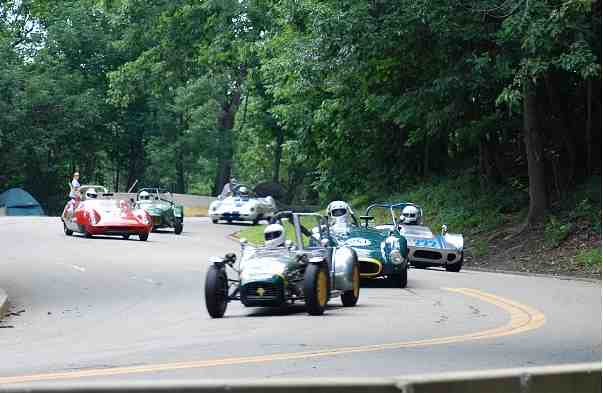Vintage Racing
A perfect Geezer Motorsport–the cars and bikes you lusted after in your youth doing wheel to wheel racing in a convivial atmosphere reminiscent of racing in the 50’s. There are vintage races for road racing cars and bikes, drag racing cars and bikes, stock cars, midgets and dirt track cars, dirt track bikes and probably others I don’t know about.The racing happens all around the USA and around the world. A typical race weekend will include a hundred or so beautifully prepared cars or bikes, racing an a variety of classes. Just walking the pits and talking to the owners is a fulfilling experience. But it’s ever so much more fun to do.
If you want to get in on the fun, the first thing to do is to find out what sanctioning body holds races in the area you want to race in and see what their rules and regulations are. You don’t want to add a lot of expensive parts to a race car only to find they aren’t legal. Rules for vintage racing tend to follow the rules from the applicable period that were promulgated by the major sanctioning body of that era. For example, road racing cars are generally covered by the SCCA GCR’s (General Competition Rules) of the years the sponsoring body recognizes. In the Northwest, for example, a major sanctioning body is SOVREN (Society of Vintage Racing Enthusiasts). They recognize three broad classes: Vintage, Historic, and exhibition. Vintage is cars produced before 1962 and the preparation rules follow the 1962 SCCA GCR, Historic is cars produced before 1969 and follow the ’69 GCR and exhibition is for significant racing cars built prior to 1979, like Formula 1, Can Am, Trans Am, Indy cars, etc.
Build or Buy
The easiest, and by far the cheapest way to get started in vintage racing is to buy a car or bike that is already competing and has an extensive logbook (the logbook is where technical inspectors record their approval of the safety of the car for each event and note any discrepancies). Just flipping through the logbook will tell you a lot about a vehicle. It sounds like fun to build your own, especially if you are considering racing a production-based car, but that’s an expensive route and race vehicles of that type sell reasonably inexpensively. There are always people moving up or changing the kind of cars they drive, and since this is generally a sport for older racers, there are always people retiring from the sport. This makes for a good market and low prices.
You can also make big mistakes in building your own racer, and wind up with an uncompetitive, unsafe or unreliable vehicle. Or, as in my case, one that was not accepted by my local sanctioning body.
At the top end of Vintage Racing are cars that sell for multiple millions–Ferrari 250 GTOs, 375MMs and Testarossas, Maserati Birdcages–exotica of all types, and bikes that sell in the high five figures. In the middle are real races cars and bikes that were built for customers and raced in local club racing–even as there is today. These sell for a wide variety of prices, starting at around $15=20K and ranging upward. If you’re set on racing “real” race cars or bikes you can find almost anything. The asking price is only one factor to consider. Some “factory racers” can be maintained fairly inexpensively, but some can be a serious burden. Don’t fail to research the cost of drivetrain rebuids and body/frame/suspension components.
Your Skills, Your Health
All sanctioning bodies require proof of your skill level. Generally you can attend a racing school or two, get certificates of completion, and then perhaps attend a school put on by the sanctioning body. After that you’re allowed to participate in the less demanding events as a novice, and your performance is watched closely. Eventually you are credited as a capable driver and licensed. Most sanctioning bodies accept the license of other organizations–for example SOVREN accepts SCCA and FIA licenses as well as licenses from other vintage racing organizations.
You need a current medical card to compete, and this requires a very thorough physical from your doctor. A standard physical will not do, you need to bring the medical card form to your doctor and have him complete it. the test often include cardiac stress tests, vision, hearing and reaction tests. The older you get the more frequently you have to have physicals. It’s a good idea anyway–many racers have been saved from serious physical consequences by their annual physical.
Summary
Vintage racing of all kinds is a great deal of fun, and the camaraderie is fabulous. You’ll find a great number of new friends with similar interests and challenges. It’s not cheap, but it can be reasonable. I’ve know family men with modest incomes that do it with careful budgeting. Start by attending a few events and see if you like the people and the excitement. But be careful, racing is a disease, and there’s no known cure.
